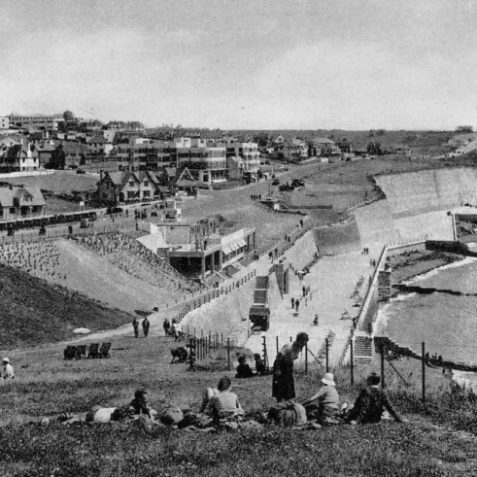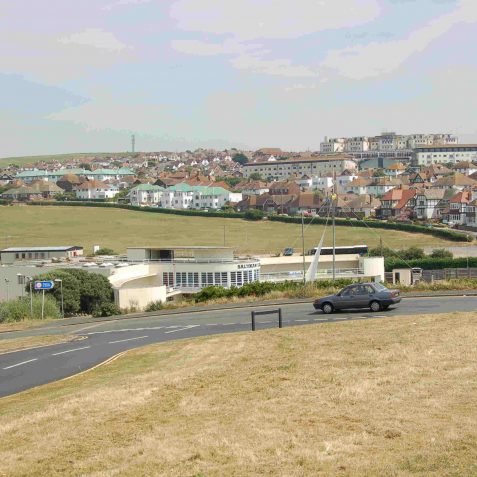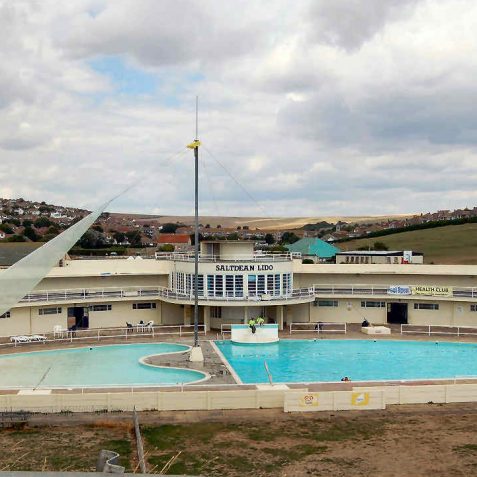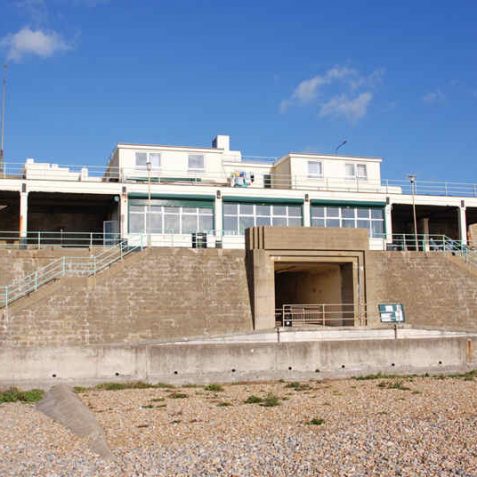Construction of present estate began in 1916
Please note that this text is an extract from a reference work written in 1990. As a result, some of the content may not reflect recent research, changes and events.
a) HISTORY: Saltdean is now a large housing estate, but for centuries it was an open area of downland and furze with a few isolated farm buildings and cottages, the oldest remaining being the mid-eighteenth-century Lower Bannings Farmhouse and barn still standing at 38-42 Bannings Vale. The area was probably named from the salty sea-spray that covered the grass after storms, and Saltdean was mentioned by name in a survey of about 1667. Saltdean Gap gave relatively easy access to the beach and was often used by smugglers, so in 1834 a row of coastguard cottages was erected near the cliff top. The cottages were demolished in 1937 but one, the post-office and store, was demolished a little later than the others and Teynham House may be seen to have been erected around it.
The history of the present estate began in 1916 when the Beard estate was acquired by speculator Charles Neville as part of his dream to develop all the land between Rottingdean and Newhaven. The area was requisitioned for agricultural use during the First World War, but in 1919 Neville sold plots in what is now Peacehaven, and he started development at Rottingdean Heights in 1923. The purchase of the Saltdean area was completed in 1922 and 1925, and in 1924 Neville established the Saltdean Estate Company in an office by the coastguard cottages. Miles of new roads were pegged out and surfaced with chalk quarried from a pit in Greenbank Avenue. A small railway was used to convey the materials along the length of Saltdean Vale.
Fortunately much stricter planning control was exercised than at nearby Peacehaven and no shacks or wooden buildings were allowed. In 1928 that part of the estate to the west of Longridge Avenue, as part of the parish of Rottingdean, was incorporated into the county borough of Brighton and development naturally proceeded more rapidly with the services now offered by the corporation. By the Second World War the Saltdean Park area and the Mount estate were largely complete, and the Estate Company had built the Lido, the Ocean Hotel, several blocks of flats, and the Smuggler’s Haunt tea-rooms at the gap. Development of the Saltdean estate continued after the war until the 1970s, the Estate Company having been acquired by Homemakers Ltd. In 1981 the population of the Brighton part of Saltdean was just under 5,000 {277}.
Any numerical cross-references in the text above refer to resources in the Sources and Bibliography section of the Encyclopaedia of Brighton by Tim Carder.
The following resource(s) is quoted as a general source for the information above: 44,201,202












Comments about this page
This was a welcome sight for me when I was training for a number of marathon runs as it meant that after being dropped off at Worthing Pier I was almost home; about a mile straight up the vale. I lived in Saltdean for 17 years after 24 in Whitehawk and a couple in Denton (Newhaven). Now we’ve been in Spain for five and a half years and it’s a different way of life altogether. Saltdean was good though. Just a shame that the Secondary School serving the area is so poor, as the primary school was brilliant.
Like so many others I found this site quite by chance! Am I the first to add a comment about Sunny Saltdean?Hard to believe! My name is Chris Wrapson, my family moved from Woodingdean to Saltdean in 1956, I was aged 13 at that time. I have a younger brother John and at that time, an older sister Jackie. After 52 years, I still live here in Saltdean. Over the years I have made so many good friends, to name a few from the early days: Brian Page, Roger (Podge) Taylor, Twinkle Tucknott, Alan Brown, Edie Edwards, Roger Hemsley, Les Edwards, Malcom Petty, John Branch, Peter Dutton (Grimble), John and Dave Huxley, Bob Titchener, Hedley Revett, Andrew (Snowy) Noble, Tim Neal, Doug Endno, Andy Workman, Colin Allen, Barry Graves and Steve Ripley. Of course, all the lovley ladies as well: Lesley, Glenda, Pat, Anna, Sonia, Christine, Margarite, Sandra, Barbara, Nesta, Hilary, Marion, Ann and Pauline. I apologise to whoever I have missed out! I made many more friends in latter years, sadly some no longer with us. Saltdean was great place in those days to be a teenager, the beach,sea and cliffs, the lido, Butlins Ocean Hotel, Rottingdean and it’s swimming pool, the downs, and a good youth club. Most of all the Oak Leaf Coffee Bar. All the names above would remember it. However, there seems to be some doubt as to the actual year it opened as a coffee bar, was it 1958 or 1959? We know it sadly closed in September 1962. Hopefully someone out there who remembers the Oak Leaf will contact us as we would like to arrange a 50th Anniversary at the Lido, or the Beach Cafe. Reunions were arranged in the 1980s and 90s and were well attended. The last one being at The Plough, Rottingdean. It would be nice to think that apart from us lot still living in the Saltdean area, there are more Oak Leafers still in the land of living! I can be contacted on 01273 306776 or christopher.wrapson@ntlworld.com
Chris. You must be Nigel’s dad? Tell him Hubby said hi. Your back garden seemed much longer when running buck naked!
These buildings were never a farmhouse. The original Bannings farmhouse was at the back of number 38 and was demolished to make room for these buildings which were constructed in 1934/5.
Hi Chris. Yes, I remember. it was 1959 the Oak Leaf opened. Martin Martin and his good lady owned it, and when he sold it he went to the “Hole in the Wall” in Seaford. I saw him in the mid 60s and joked with him that it was us youngsters that bought him the pub. They used to travel over to France and would always look out for us to say hello. Yes I knew all the above names – a few missing. From Rottingdean: Melvin Davies, Tony Morgan, Tim and Roger Copper, Alan Cruse, Mike Cohen and Richard Polley. From Saltdean: Pete Milton, Ginger Daglish, Micky Hayward, Dave Bilcliff, Kenny Creswall, Raymond Cannon, Chas Harwood. And from Peacehaven: Zac Lawson. Have not really seen anyone since the early 60s. Saw Twinkle in New Zealand a couple of times, then we worked together in Newhaven along with Barry Graves. Bumped into Kenny Creswell in Harlow new town in 1968. John Branch I saw few times when he was travelling between England and France. Only others I have seen in recent years (ie 2000+) are Steve Ripley and Barry Graves. Drove round Saltdean a few weeks ago (my sister still lives there), all built up now and what have they done to the Ocean Hotel?! Must be the same people who restored the Palace Pier – say no more!
Hi Mick. Great to hear from you. You will find some info about the Oak Leaf cafe on this site – click here – where there is also a link to The Oak Leaf Story. Or just go to http://www.saltdean.info History section. Regards.
There is so much interest in Brighton from the past, and sometimes a name pops up that just might be someone that you knew at some time. Christopher Wrapson is a name that I remember. I wonder Chris, did you go to Fitzeherbert School in Woodingdean in the 50s, and are you the same Chris Wrapson that supported Brighton Tigers ice hockey team?
Up to the age of 4 (1947-1951) I lived at 74, Hailsham Avenue, Mount Estate, Saltdean. Recently, as part of my detailed search for my family history, I returned to Hailsham Avenue only to discover that the Council at some stage had changed all the numbers. I think No 74 is now somewhere in the 20s. Does anybody know when it happened and also where I can find information about the changes so I can locate my former house – a bungalow. 67 years on from when we left Hailsham Avenue I’m struggling to remember what the bungalow looked like.
I see what you mean, Dudley. In my copy of Kelly’s Directory for 1947, I see the only house numbers given in Hailsham Ave. are from 65 through to 87 (odds and evens). By the time of Kelly’s ’73, the numbers became 2 to 28 (evens) on the north side, and 1 to 17 (odds) on the south (it seems a lot more logical). Possible change to house numbering can easily be overlooked. If the Council are not able tell you themselves, I think one fairly reliable way of finding the approximate year when the house numbers were re-organised in Hailsham Ave. would be to visit The Keep, say, and find the earliest Kelly’s showing the newer arrangement. It may take a bit of time, but most volumes should be available, making it fairly easy to narrow the year down. Incidentally, the listing I have for No. 74 in 1947 shows “Gladevie Hy [Henry?]”, probably resident right up to the time of your family’s move into the bungalow. – Good luck in your research.
Many thanks for your excellent advice, Sam.
Add a comment about this page